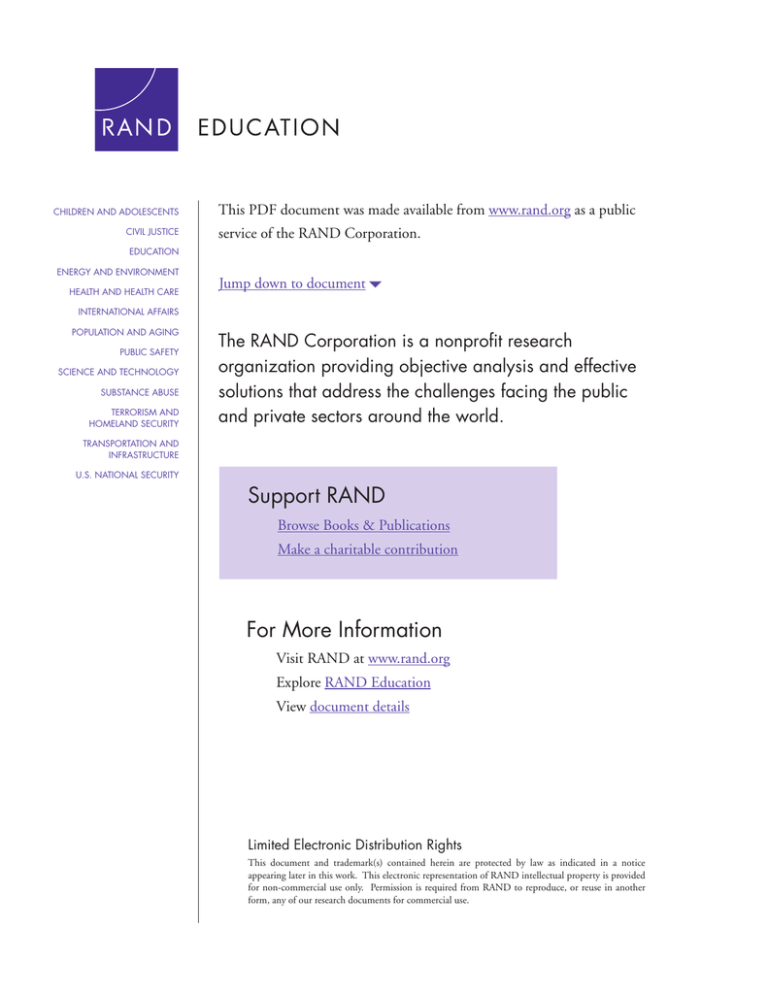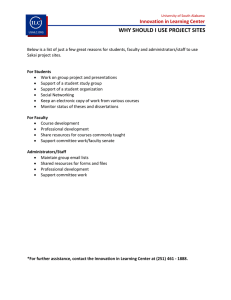6 om as a public service of the RAND Corporation.
advertisement

CHILDREN AND ADOLESCENTS CIVIL JUSTICE This PDF document was made available from www.rand.org as a public service of the RAND Corporation. EDUCATION ENERGY AND ENVIRONMENT HEALTH AND HEALTH CARE Jump down to document6 INTERNATIONAL AFFAIRS POPULATION AND AGING PUBLIC SAFETY SCIENCE AND TECHNOLOGY SUBSTANCE ABUSE TERRORISM AND HOMELAND SECURITY The RAND Corporation is a nonprofit research organization providing objective analysis and effective solutions that address the challenges facing the public and private sectors around the world. TRANSPORTATION AND INFRASTRUCTURE U.S. NATIONAL SECURITY Support RAND Browse Books & Publications Make a charitable contribution For More Information Visit RAND at www.rand.org Explore RAND Education View document details Limited Electronic Distribution Rights This document and trademark(s) contained herein are protected by law as indicated in a notice appearing later in this work. This electronic representation of RAND intellectual property is provided for non-commercial use only. Permission is required from RAND to reproduce, or reuse in another form, any of our research documents for commercial use. This product is part of the RAND Corporation technical report series. Reports may include research findings on a specific topic that is limited in scope; present discussions of the methodology employed in research; provide literature reviews, survey instruments, modeling exercises, guidelines for practitioners and research professionals, and supporting documentation; or deliver preliminary findings. All RAND reports undergo rigorous peer review to ensure that they meet high standards for research quality and objectivity. Career Paths of School Administrators in Illinois Insights from an Analysis of State Data JEANNE RINGEL, SUSAN GATES, CATHERINE CHUNG, ABIGAIL BROWN, BONNIE GHOSH-DASTIDAR TR-123-WF May 2004 Prepared for the Wallace Foundation The research described in this report was prepared for the Wallace Foundation by RAND Education. The RAND Corporation is a nonprofit research organization providing objective analysis and effective solutions that address the challenges facing the public and private sectors around the world. RAND’s publications do not necessarily reflect the opinions of its research clients and sponsors. R® is a registered trademark. © Copyright 2004 RAND Corporation All rights reserved. No part of this book may be reproduced in any form by any electronic or mechanical means (including photocopying, recording, or information storage and retrieval) without permission in writing from RAND. Published 2004 by the RAND Corporation 1700 Main Street, P.O. Box 2138, Santa Monica, CA 90407-2138 1200 South Hayes Street, Arlington, VA 22202-5050 201 North Craig Street, Suite 202, Pittsburgh, PA 15213-1516 RAND URL: http://www.rand.org/ To order RAND documents or to obtain additional information, contact Distribution Services: Telephone: (310) 451-7002; Fax: (310) 451-6915; Email: order@rand.org - xi SUMMARY According to anecdotal reports, schools in the United States are having difficulty recruiting and hiring school administrators, and the reigning perception has been that the difficulty stems from a general shortage of people qualified to be school administrators. This perception was called into question recently by three studies based on empirical information on administrative careers. These studies, all of which are summarized in a Policy Brief by The Wallace Foundation (2003), suggest that the supply of nominally qualified (e.g., certified) individuals available to serve as school administrators is indeed adequate, but that the practices of human resources departments in schools and districts may be preventing schools from selecting the best candidates. By juxtaposing the conventional wisdom against the empirical realities, the studies reflect the importance of using empirical data where possible to monitor and better understand the labor market for school administrators. In this report, we further develop this understanding of the careers of school administrators through an in-depth analysis of administrative data from the state of Illinois. We describe in detail what state-level administrative data can reveal about the careers of school administrators in the state, what the data cannot reveal, and how further research and data collection might be directed to build on the advantages of systematic administrative data in order to provide a better understanding of the relationship between administrative career paths and learning outcomes for students. An analysis of career paths sheds light on several questions of interest to states and school districts. Public sector organizations often place value on the racial/ethnic and gender composition of their workforce. And many districts are working to ensure gender and racial/ethnic diversity among school administrators and to eliminate inequities in promotion rates to administrative positions. As a result, state and district policymakers may be interested in whether trends affecting school administrators with respect to racial/ethnic and gender - xii - composition reflect progress toward statewide or local objectives. Policymakers at the state and local level are also concerned about turnover among school administrators, a concern based on the belief that high levels of turnover deny schools the leadership stability they need to succeed. Career path analyses make it possible to investigate important trends in the level of administrative turnover, and to look at whether particular types of schools are facing substantially higher turnover than other schools are. With passage of the federal No Child Left Behind Act and statelevel educational accountability initiatives, states and districts became very concerned about school quality, as measured by student achievement for all subpopulations of students. As a consequence, districts and states found that they would benefit from knowing what characteristics of administrators best promote improved achievement for all students. With better data, analyses of administrators’ career paths might ultimately help inform this key policy question, as well. Previous work by the RAND Corporation (Gates, Ringel, and Santibañez, 2003) provided a national overview of the careers of school administrators based on available national data. However, because national data are cross-sectional and typically cover only a sample of the education workforce, they cannot support a true analysis of career paths. It is possible to examine how the population of school administrators changes over time and how the characteristics of administrators are related to school characteristics, but it is not possible to consider transitions into and out of different positions or to compare those who move into administration with those who do not. Administrative data, on the other hand, are systematically collected, which means it is possible to track individuals over time and across schools and districts, and to cover the entire workforce of public professional educators. These data support rigorous and comprehensive longitudinal analyses on careers, career paths, and turnover. This report presents an approach for using administrative data for career path analyses, as well as the results from applying such analyses to the Illinois data. The first of our four research objectives was to provide a descriptive overview of current and former Illinois school - xiii - administrators and their careers. Our descriptive analysis examined trends over time for the demographic characteristics of school principals, assistant principals, other administrators, and superintendents. We then focused on school principals and superintendents, examining the positions these individuals had held previously. Finally, we examined the positions held by first-time principals in the years following their move to the principalship. Our second research objective was to identify factors of the individual and the school in which he or she works that are related to whether or not that individual transitions to a principalship or superintendency. We used a longitudinal event history modeling approach to examine the educators’ decision to become an administrator. Our third research objective was to identify characteristics associated with principal mobility and attrition, which we addressed using an event history approach similar to that used for the second objective. Our fourth objective was to consider how state administrative data might be used to help policymakers better understand the link between school administrators and student learning. DESCRIPTIVE OVERVIEW REVEALS THAT CHARACTERISTICS OF ILLINOIS SCHOOL ADMINISTRATORS HAVE CHANGED AS THEIR NUMBERS HAVE INCREASED MODESTLY Our analysis revealed modest growth in the number of school administrators in Illinois, but not as a result of increases in the number of principals and superintendents. Between 1987 and 2001, the total number of school administrators grew by 21 percent (which is slightly lower than the 24 percent increase in the number of teachers during this timeframe), but this growth was not evenly distributed across administrative positions. We found that while the number of assistant principals increased by 71 percent and the number of other administrators grew by 36 percent, the number of school principals increased by only 10 percent and the number of superintendents actually declined by 5 percent. It is important to note, however, that we found no evidence that this growth in the number of positions—which translates into demand for school administrators—ran up against a limited supply of candidates. Our - xiv - analyses revealed no clear time trend in terms of the probability that educators in Illinois transition from teaching to the principalship. A survey of those obtaining administrative (T75) certificates in Illinois in the 1999–2000 school year (DeAngelis, 2003) also supports the notion that there is no supply crisis. Of the approximately 1,400 individuals who received the T75 certification in 1999–2000, seven out of ten had applied for an administrative position, but only four out of ten were actually working as administrators. Female representation among all categories of school administrators in Illinois grew dramatically between 1990 and 2000. Even within the superintendency, where female representation is the lowest for the administrative positions considered, 14.4 percent of superintendents were women in 2000, compared with only 6.3 percent ten years prior. As for Illinois’s principals, only 26 percent were female in 1990; but by 2000, women, at 46.6 percent, were nearly a majority. This trend is supported by a similar increase in the proportion of new principals (i.e., principals in their first year) who were women. By 2000, women were a clear majority—61 percent—of the state’s new principals. The proportion of principals who are minorities (i.e., members of a racial or ethnic minority group) has also increased over time. In 1990, only 12 percent of Illinois principals were minorities; by 2000, 18 percent were. CAREER PATH ANALYSES REVEAL THAT GENDER AND RACIAL/ETHNIC COMPOSITION REMAINS A CONCERN As mentioned earlier, public sector organizations often place value on the racial/ethnic and gender composition of their workforces. Specifically, governments often strive to ensure that the composition of their workforce reflects the composition of the population as a whole, and that the composition of management in government organizations reflects that of the government workforce as a whole. Despite the gains described above, the results of our multivariate analysis of career transitions raise some important concerns for policymakers on both scores. - xv - First, we found that the gender gap is alive and well. When we controlled for other characteristics, men were still three times more likely to become principals overall. When we accounted for the possibility of becoming an assistant principal, we found that men were nearly 2.5 times more likely to become principals directly (that is, without first serving as an assistant principal), and over 2.5 times more likely to become assistant principals. However, we also found that conditional on having become an assistant principal, women were nearly 20 percent more likely to become principals. This suggests that the source of the gender barrier may lie at the point where the individual makes the initial decision to move from teaching into administration. In addition, the results of our analysis suggest that the gender gap is not a problem specific to high schools. Women represented well over half of the principals in both elementary and combined schools, but only 31 percent of middle school principals and 26 percent of high school principals in 1999-2000. However, relative to women in elementary schools, women in middle and high schools are actually more likely to become principals or assistant principals. What this gender gap in the transition to administrative positions is caused by, we do not know. It could stem from differences between men and women in their preference for administrative careers, from gender-based discrimination in promotion, or from a combination of the two; our analysis did not allow us to identify a cause. We also found that the administrative pipeline may not be well primed to sustain increases in the proportion of minority principals. Here, the concern is not with the rate at which teachers transition into administration, but with the pool from which administrators come. In the 1999–2000 school year, minorities made up a total of about 41 percent of the entire student population of Illinois, compared to only 15 percent of the teaching force, 19 percent of all principals, and 4 percent of all superintendents. In contrast to what was found for gender representation, minorities were found to be underrepresented in the teaching pool relative to the overall population, but well represented in school administration relative to the teaching pool. Overall, - xvi - however, our analyses provided no evidence that African-Americans are either more or less likely than whites to become principals. PRINCIPAL TURNOVER IS NOT PARTICULARLY HIGH IN ILLINOIS, BUT GREATER TURNOVER IS FACED BY SCHOOLS SERVING HIGH-MINORITY STUDENT POPULATIONS Our descriptive analysis of individuals entering the principalship for the first time in the late 1980s and early 1990s suggests a high level of stability in Illinois schools. After six years, 60 percent of these individuals were still principals in the state of Illinois; and of these principals, 38 percent were still principals in the same school, and 22 percent had assumed a principalship at another Illinois public school. Of those who moved to another public school, about half remained in the same district and half changed districts. A very small fraction, 3 percent, of the first-time principals had returned to teaching six years later; 15 percent had assumed some other administrative position; and about one-fifth had left the Illinois public school system. Our multivariate analysis of principal turnover also suggests stability. Over the timeframe 1987–2001, turnover among all school principals was 14 percent, and only about one-fifth of it was attributable to principals leaving the system. However, we did observe some interesting variation by school characteristics. We found that principals in schools with a larger proportion of minority students were more likely to change schools within the public school system and to leave the principalship but remain in the system. This suggests that schools serving higher proportions of minority students may have a harder time retaining principals. ADMINISTRATIVE DATA ARE SERIOUSLY LIMITED BY THEIR LACK OF ADMINISTRATOR QUALITY DATA Our research is perhaps most illustrative, however, in identifying what it cannot tell us about school administrators. Specifically, our research highlights the fact that administrative data provide little insight into the performance of school administrators. Ultimately, the issues of greatest interest to policymakers are whether the education system is promoting and retaining individuals who are effective administrators, and which individual characteristics (including career - xvii - experiences) are associated with administrative effectiveness. This report provides recommendations for data collection efforts that could help researchers and policymakers begin to address these issues.



